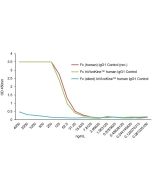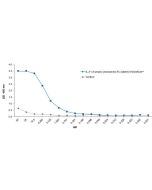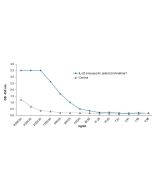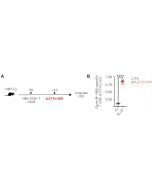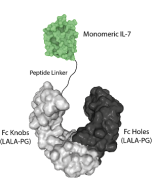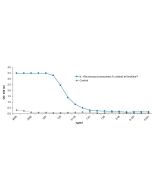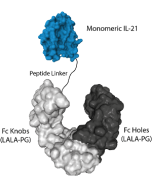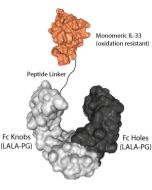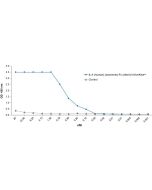Cookie Policy: This site uses cookies to improve your experience. You can find out more about our use of cookies in our Privacy Policy. By continuing to browse this site you agree to our use of cookies.
AdipoGen Life Sciences
IFN-β (mouse) (monomer):Fc (silent) InVivoKine™
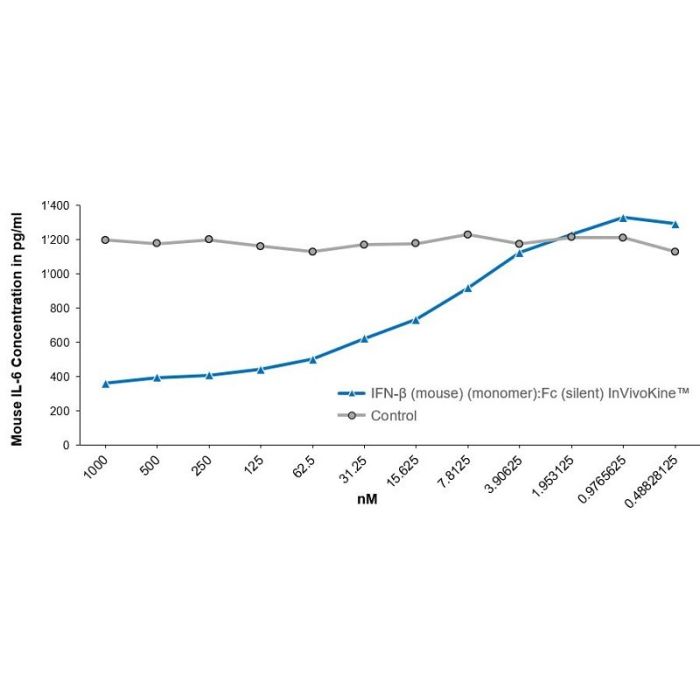
| Product Details | |
|---|---|
| Synonyms | Interferon beta (mouse) (monomer):Fc (LALA-PG) KIH (human) (rec.); Interferon beta; Ifnb1; Interferon-β |
| Product Type | Protein |
| Properties | |
| Source/Host | HEK 293 cells. Produced using animal component-free medium. |
| Sequence |
Mouse IFN-β (aa 22-182) is fused at the C-terminus to the Fc portion of human IgG1 (LALA-PG) (Knobs-into-Holes technology) (see reference: J.B. Ridgway, et al.; Protein Eng. 9, 617 (1996)). |
| Crossreactivity | Mouse |
| Specificity |
Binds to mouse IFNAR. The Fc contains the mutations LALA-PG that abolish the interaction between the Fc and FcγRs and therefore Fc undesirable effects. |
| Biological Activity |
Inhibits the secretion of IL-6 induced by LPS in Raw 264.7 cells. EC50 is 0.7- 5ng/ml. |
| MW | ~ 65-68 kDa and 28kDa (SDS-PAGE) |
| Purity | ≥95% (SDS-PAGE) |
| Endotoxin Content | <0.01 EU/μg protein (LAL test). |
| Concentration | After reconstitution: 1mg/ml |
| Reconstitution | Reconstitute with 50μl endotoxin-free water. |
| Accession Number | P01575 |
| Formulation | Lyophilized. Contains PBS. |
| Protein Negative Control |
Fc (silent) InVivoKine™ (human) IgG1 Control (Prod. No. AG-35B-0018) |
| Other Product Data |
Uniprot link P01575: IFN beta (mouse) |
| Shipping and Handling | |
| Shipping | BLUE ICE |
| Short Term Storage | +4°C |
| Long Term Storage | -20°C |
| Handling Advice |
After reconstitution, prepare aliquots and store at -20°C. Avoid freeze/thaw cycles. Centrifuge lyophilized vial before opening and reconstitution. PBS containing at least 0.1% BSA should be used for further dilutions. |
| Use/Stability |
Stable for at least 6 months after receipt when stored at -20°C. Working aliquots are stable for up to 3 months when stored at -20°C. |
| Documents | |
| Product Specification Sheet | |
| Datasheet |
 Download PDF Download PDF |
Interferons (IFNs) are a class of cytokines that initiate a cascade of immune responses against pathogens. During an infection, pattern recognition receptors (PRRs) sense pathogen-associated molecular patterns (PAMPs), leading to the induction and secretion of IFNs by infected immune or epithelial cells. IFNs bind IFN receptors on the surface of neighboring and/or immune cells, triggering a signaling cascade to induce a suite of IFN-stimulated genes (ISGs) that directly mediate the anti-pathogenic effects of IFNs. Each type of IFN has its own specificities, such as different receptor utilization, expression patterns and distinct downstream genes. IFN-α and IFN-β are type I IFNs, produced by most cells in response to infection. Type I IFNs bind to their receptor, IFNAR, leading to the phosphorylation of transcription factors (TFs) STAT1 and STAT2, which bind IFN regulatory factor (IRF) 9 to form a complex called the ISG factor 3 (ISGF3). ISGF3 translocates to the nucleus and induces ISGs.
The IFN-β (mouse) (monomer):Fc (silent) InVivoKine™ is produced by using two different vectors, one encoding for the IFN-β (mouse):Fc (LALA-PG) Knobs sequence (synthesizing a protein of 65-68 kDa) and one encoding for the Fc (LALA-PG) Holes sequence (synthesizing a protein of 28 kDa). Both vectors transfected into HEK293 cells produce both Fc molecules (Knobs-into-Holes technology; J.B. Ridgway, et al.; Protein Eng. 9, 617 (1996)) required for dimerization of the Fc moieties and for secretion of the final protein IFN-β (mouse) (monomer):Fc (silent) InVivoKine™. The LALA-PG mutations inhibit binding to FcγRs and C1q, while FcRn binding and Fc stability remain unaffected.
InVivoKines™ are a new generation of recombinant fusion proteins for immunotherapeutic, preclinical and translational in vivo research, developed and manufactured by AdipoGen Life Sciences.






